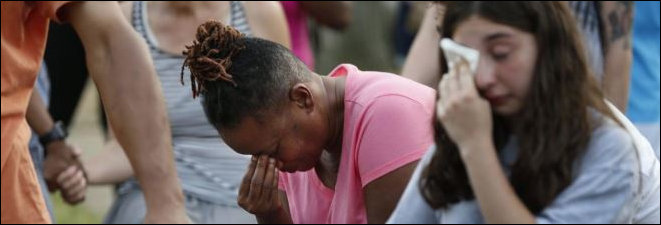
Families in south Richmond have long held community cookouts at the Carter Jones Park. Last Sunday evening, an altercation broke around at a basketball/skateboard facility nearby. Gunshots were fired. Nine-year-old Markiya Simone Dickson and an unnamed 11-year-old boy were struck by bullets. Markiya died.
Community members and city leaders gathered at a vigil yesterday to protest the violence. One of the city officials in attendance, Richmond Public Schools Superintendent Jason Kamras, addressed the impact of trauma upon school children.
Dozens of children in the park witnessed the tragedy, said Kamras, as reported by the Richmond Times-Dispatch. “They will carry that trauma into their lives, and certainly into their classrooms. Sadly, this is all too common for many of the young people in Richmond Public Schools.”
As Richmonders held their vigil, First Lady Pamela Northam was addressing Southwest Virginia’s Rural Summit for Childhood Success across the state in Abingdon. Shootings that kill random by-standers are rare in that part of Virginia, but child abuse and child neglect are far from uncommon. According to the Washington County News, Northam said:
The experiences that children face in the early years of their lives have a profound impact on their development and life outcomes. Challenges such as trauma, food insecurity, [and] insufficient early childhood learning experiences can all affect mental, emotional and physical development. … What happens in early childhood doesn’t stay in early childhood.
To the therapeutic clerisy that runs Virginia schools and state bureaucracy, the usual answer to the very real problem of childhood trauma is more counseling… or more mental evaluations… or more of something that require the hiring of more professionals to do the counseling and evaluations. Indeed, Richmond and Chesterfield educators made a point of saying that their schools would make counselors available to children traumatized by the killings at Carter Jones Park.
Given the challenges of widespread violence, maybe Virginia communities do need to devote more resources to counseling, foster care, and other social services. But here’s what you never hear from the therapeutae these days: a crackdown on the people who commit the violent acts in the first place. The thrust of public policy in Virginia is to dismantle the supposed “school-to-prison pipeline” and address the over-representation of African-Americans in the prison and jail populations. The killers, you see, are victims, too.
But there’s another way of looking at the problem: If you want children to suffer less trauma, maybe we need to do a better job of stopping the trauma in the first place.
In the case of the south Richmond shootings, the police have been unable to identify the killers. Detectives had “little information to go on,” said Interim Police Chief William Smith. “We have had a number of tips, but we need more.”
Richmond has a high clearance rate for murders, so there is a decent chance that the killers will be identified and brought to justice. If they are, as I desperately hope they will be, I would ask a few questions — questions that hardly anyone seems to be asking these days. Did the perpetrator (or perpetrators) have an arrest record? Had they been jailed or imprisoned before? Had they been released on parole? If so, under what kind of restrictions or supervision were they operating? Could the tragedy have been prevented if the killers still had been in jail?
Maybe a tougher parole policy would have done nothing to stop the shooting. Maybe the perpetrator had experienced children traumas of his own and more counseling could have interrupted the cycle of violence. Or not. But we’ll never know if we don’t ask the questions.

Leave a Reply
You must be logged in to post a comment.